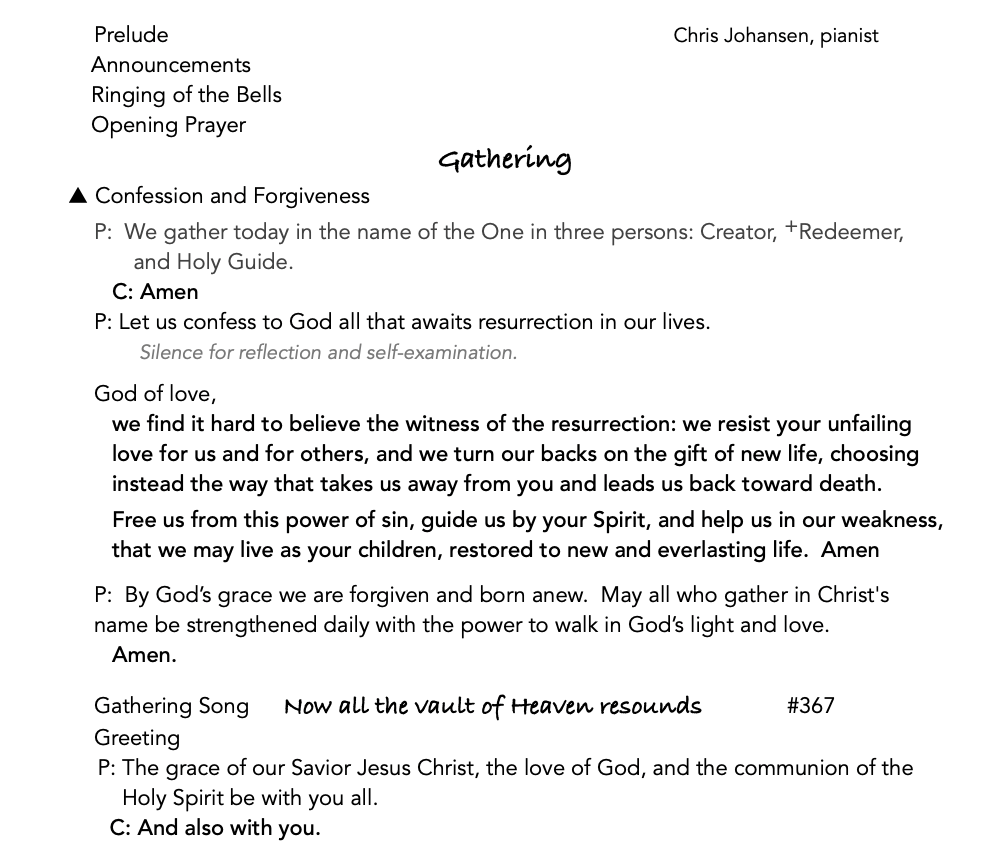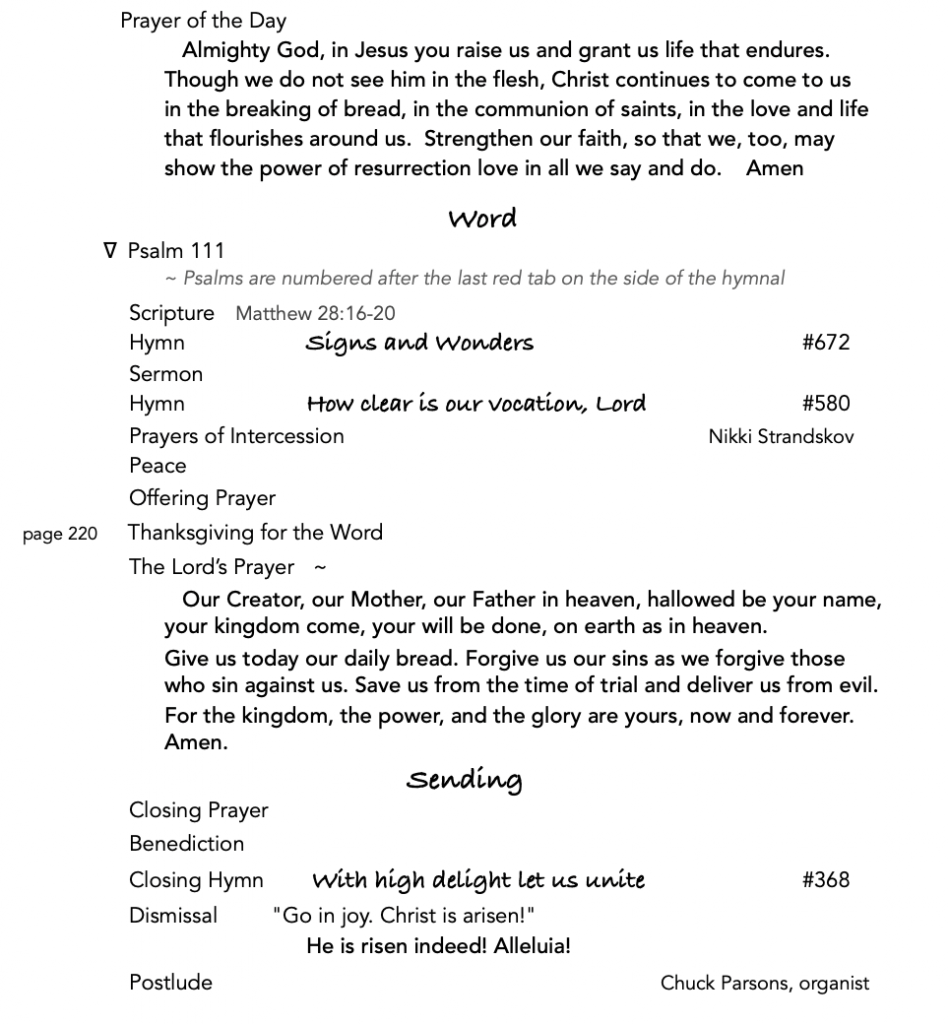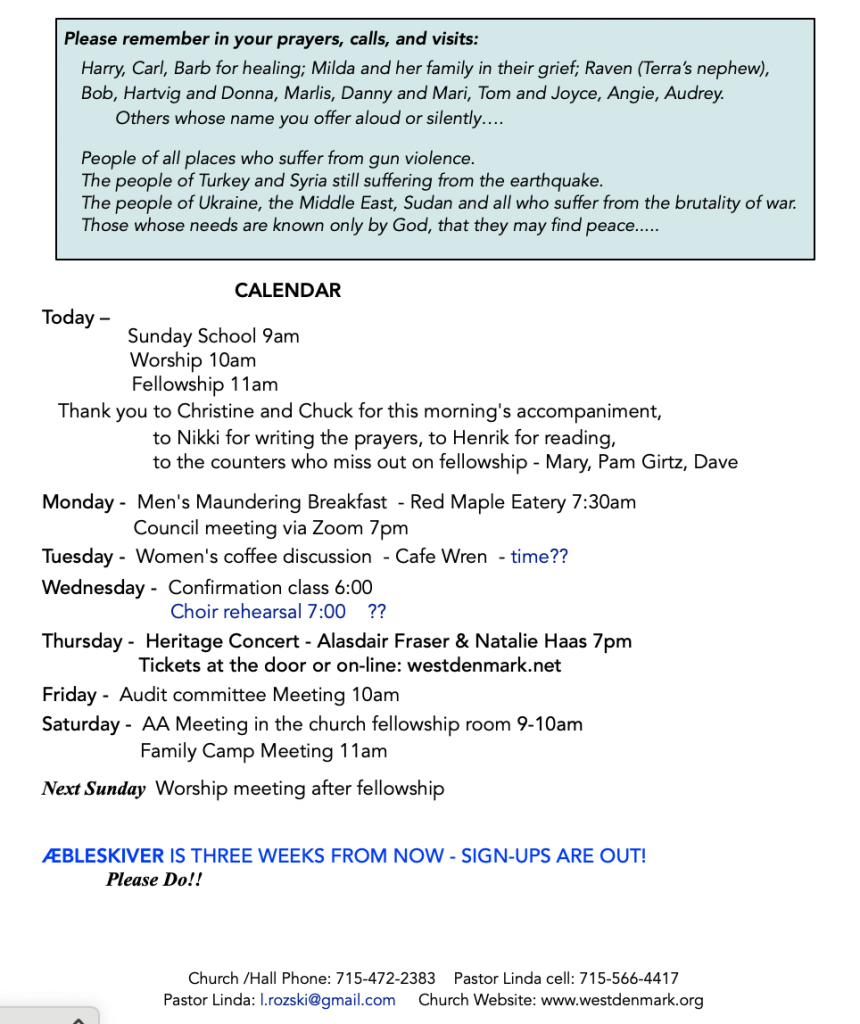Audio Recording



Matthew 28:16-20
16Now the eleven disciples went to Galilee, to the mountain to which Jesus had directed them. 17When they saw him, they worshiped him; but some doubted. 18And Jesus approached and said to them, “All authority in heaven and on earth has been given to me. 19Go therefore and make disciples of all people, baptizing them in the name of the Father and of the Son and of the Holy Spirit, 20and teaching them to keep all things that I have commanded you. And remember, I am with you all the days until the completion of the age.
Each of the four gospels ends uniquely. Mark was the first to be written and doesn’t have any post-resurrection appearances. The women hear the good news that Jesus has risen and they run away trembling and in fear, saying nothing to anyone.
Mark’s ending is perfect in that abruptness – leaving us to kind of gasp and employ our little gray cells in wondering what happened next. How did we get from there to here? It’s the best proof of the living word that I can imagine. The witnesses said nothing, and yet…
Luke and John each have multiple endings and many satisfying visuals – walking the road to Emmaus and becoming known in breaking the bread; Jesus entering a locked room and letting Thomas poke his finger into the still visible wounds; or in John, cooking up a shore lunch of fresh fish and taking Peter aside for a chat, leaving us with lots of poignant dialog.
But, it seems Matthew is a bit of a let down. There are just these few sentences and they’re kind of bland and churchy. It’s got no pizzaz, nothing for our imaginations to work with or relate to. He seems to be addressing questions of the community that Mark’s abrupt ending didn’t satisfy. Ending a sermon is the hardest part of writing one, so I can commiserate with him. Ending a gospel must be difficult.
So, we should look again.
Jesus and the disciples are from Galilee, sending them there is not unexpected. Jerusalem wasn’t a safe place – their accents gave them away as Galileans and associated them with Jesus. Besides, why stay? So they went home. But, it wasn’t just to Galilee that they were sent. I hadn’t really thought about this before. You know the way we read things, skimming over words until we get to the main point? At least I do that. I assumed that the forlorn disciples went home in some state of fear and confusion, kept in touch, and, one night at the Capernaum Fish & Chips, the risen Jesus got a message to them, called them outside to a place apart, and commissioned them.
Well, I’m missing the significance of the one detail Matthew does give. It wasn’t just, “Go home and I’ll find you.” He told them to go to a mountain. The mountain.
Whether or not the Sermon on the Mount all came tumbling out in one sitting or is a compilation of many teachings, Jesus is frequently seen climbing mountains in his early ministry as he ‘disciples’ the men, and possibly some women, he called to follow him. The site now known as the Mount of Beatitudes is on the northwestern shore of the Sea of Galilee, between Capernaum and Gennesaret, on the southern slopes of the Korazim Plateau.
It makes beautiful, poetic sense that they were called back to the mountain of their teaching, the mountain where Jesus gave the new Commandments. It makes this less of a disappointing ending.
They circled back to the mountain, to the beginning, to the place of presence and vision. These guys hadn’t seen anything. We need to remember that. They didn’t see or hear the angel, they didn’t see the newly opened, and yet inexplicably empty, tomb. They only heard of the experience from the women. Women were not regarded as competent witnesses in Jewish courts, so their testimony isn’t given as proof, so much as one more aspect of this story to take on faith.
The eleven go to the mountain, and Jesus does appear to them as he had promised. “And when they saw him, they worshiped him; but some doubted.” I do love that detail. Perhaps it was Thomas, but if so, he’s not alone. Some doubted what they were seeing. Some couldn’t get their minds to accept the two opposing realities of death and life standing there before them. Wounds presumably visible – not bleeding, not healing. I imagine that all of them had an element of doubt – fear, awe, bewilderment – the mix of emotions and thoughts had to be overwhelming.
And Jesus approached and said to them, “All authority in heaven and on earth has been given to me.” That was what the Tempter had offered. Remember? Satan took him to a very high mountain and showed him all the kingdoms of the world and their splendor; 9and he said, ‘All these I will give you, if you will fall down and worship me.’ Jesus resisted, and according to the way of the world, he lost. Well… Not!
I don’t really know what it means to have ‘all authority’ – except the obvious, that God has claimed Jesus, has answered his lament from the cross – “My God, my God, why have you forsaken me?” Not forsaken, not abandoned, not put off by the humiliation and shame and death of the cross. But claimed as child, as agent of redemption, as One with the One who has all authority to give.
“Go therefore and make disciples of all people, baptizing them in the name of the Father and of the Son and of the Holy Spirit, and teaching them to keep all things that I have commanded you.”
This is the churchy bit. I like it better thinking of it as being told in the same place that the Beatitudes were taught. It’s all hypothetical, of course. We don’t have any way of knowing the ‘truth’ of any of this. But, the setting would help the disciples remember the teaching of Jesus. It would help them get over the death and betrayal; help ground their current amazement by placing the years of following him into a context, a focus. Because, it’s not just that they were to worship and believe. It’s not that we are to simply worship and believe. According to Matthew’s gospel, we are to do the will of God as interpreted in the life and ministry of Jesus, the Messiah, the Risen one. His path has been validated, his teaching vindicated. I wish Jesus or Matthew would have added the words from communion, “Do this in remembrance of me.”
Disciples of the risen Christ are to teach what Jesus taught on that mountain. We are to circle back and keep the Sermon on the Mount in view. Christ didn’t command them to teach or preach the gospel, but to teach all people to observe, to practice, to live what he had taught them. God has established Jesus’ life as the authoritative interpretation of the will and way, the rule and realm of God. “Do this in remembrance of me.” It’s not about belief, you will notice. It’s not about faith. Some doubted and were commissioned just the same. It’s about practice. Teach people to behave in this way: where the poor are honored, where those who mourn are consoled, where the outcast are welcomed, where the hungry are fed, where enemies experience compassion, where neighbors are loved despite everything that separates and divides them. Do this in remembrance of me. Let your life exceed the righteousness of words that are easily spoken, but not followed with deeds. Be holy, perfect, as your Father in heaven is perfect. Don’t think about it and admire the concept. Strive for that behavior. Of course, we will fail, but try, hold that as the standard. Keep circling back.
Do this, act in this way, behave toward others in this fashion — not so that you will be saved, or so that they will be saved —but because you already are, and because this is the way of the kingdom which has drawn near.
That’s the final word of Matthew’s gospel and an interesting difference between his and the others. “Remember, I am with you all the days — day by day by day — until the completion of the age.”
“I am with you.” In Luke, Acts and John, Jesus ascends to God, sending the Holy Spirit in his place. This doesn’t happen in Matthew. In Matthew, Jesus promises to stay and we circle back.
“1:18 Now the birth of Jesus the Messiah took place in this way. When his mother Mary had been engaged to Joseph, but before they lived together, she was found to be with child from the Holy Spirit. Her husband Joseph, being a righteous man and unwilling to expose her to public disgrace, planned to dismiss her quietly. But just when he had resolved to do this, an angel of the Lord appeared to him in a dream and said, ‘Joseph, son of David, do not be afraid to take Mary as your wife, for the child conceived in her is from the Holy Spirit. She will bear a son, and you are to name him Jesus, for he will save his people from their sins.’ All this took place to fulfill what had been spoken by the Lord through the prophet: ‘Look, the virgin shall conceive and bear a son, and they shall name him Emmanuel’, which means, ‘God is with us.’
And that, my friends, is the Good News of God in Jesus Christ, our risen Lord. God promises to be with us, day by day, every day, until the end of our ages, and on until the end of time.
Thanks be to God
